Yesterday I received a call from the people at PV Magazine who were preparing for the ‘Virtual Roundtables Europe 2020’ event on this week in Germany – i.e. Tuesday evening (now!) and Wednesday evening ‘NEM time’. I’m told the event will be recorded, with the recording available later to those who have registered, so get your skates on if interested.
(A) Trend of operational data for Oakey 2 Solar Farm
Apparently the afternoon session on Tuesday 9th in Germany (i.e. starts 21:00 NEM time) has a focus on Quality, with the conference blurb noting:
With strong winds having caused catastrophic failures at several PV arrays in recent years, managing the hidden risk is at the forefront of developer, investor and supplier minds. New module technologies boost power but also raise quality questions. Floating also presents several hidden risks.
Knowing now that this was a focus, it was not a total surprise to be asked for some data relating to the operations of Oakey 2 Solar Farm, given what I knew had happened to the plant when spring storms had ripped through ‘thunderstorm alley’ in October 2018 whilst the plant was still being constructed, causing massive damage – and leading to major delays to commissioning and operations.
Given that I keep my copy close at hand, and that it was designed for exactly this purpose, I quickly flipped open my hard-copy of the Generator Statistical Digest 2019 and flipped to the two pages of statistics included for Oakey 2 Solar Farm – the image below has been lifted from the top of the relevant ‘B’ Page in the GSD2019:
From this data we see that it was not until September 2019 that the plant was finally registered at the AEMO (i.e. at which point data started to flow into the MMS), and we see the rest of the year the plant remained in commissioning, down at low hold points.
Because the question I’d been asked related to operations through to the current point in time, I powered up this query in NEMreview v7 order to produce the following updated trend:
I’ve added some annotations to point out a few points of interest, explored briefly below.
(B) Chronology of key events
In a bit of a rush today, but have quickly pieced together the following chronology for those who are interested:
(B1) 25th October 2018 or thereabouts – storms cause major damage
I can clearly remember seeing the following startling image when one of our contacts sent this photo into us during October 2018, showing massive damage to the Oakey 2 Solar Farm which was still under construction at the time:
I was not exactly sure when this storm occurred, but scanning weather history for Oakey airport (nearest BOM measurement point) using this query in NEMreview v7 shows a large storm front passed through on 25th October 2018 with high wind speeds at Oakey airport (gusts above 100km/hour):
I’ve since found that this was also written about by Jonathan Gifford in PV Magazine under ‘Long read: What broke at Oakey’ on 7th December 2019, and would note a couple things here:
1) In this article the author wrote that “The Queensland Electrical Safety Office has confirmed that the event took place on Oct. 18” but I wonder if this is not an issue in the misinterpretation of dates – given a few factors:
(a) The extremes in wind speed seen on 25th October; and
(b) The fact that this was October 2018 (perhaps written as Oct-18?)
(c) Also the fact that, whilst there was a storm on 18th October, there were much lower wind speeds measured at the Oakey airport (query in NEMreview v7 here):
2) No matter when it happened, the plant ended up with significant damage. Also in Jonathan’s article above was the mention of “torsional galloping” as the suspected failure mode. It’s been decades since I worked in the area of remnant life and failure mode analysis, but that sure sounds like something due to wind speed effects combined with the structural design/implementation of the plant.
3) Finally, at the top of the article I noticed that Jonathan had written “challenges under the Australian sun should not be taken lightly” which is the same type of sentiment expressed by Allan O’Neil when he wrote “the NEM is a market where the details matter” in his article on 28th January suitably titled “How good is solar farming?” (which Daniel noted yesterday was referenced on the ABC and elsewhere).
Strangely, I don’t believe that neighbouring Oakey 1 Solar Farm, which was also in construction at the time, suffered any significant damage – perhaps not any damage at all. I certainly can’t remember hearing anything about it.
(B2) 13th March 2019 – Oakey 1 Solar Farm operational
As noted in Giles’ article on RenewEconomy on 15th March 2019, the Oakey 1 Solar Farm began exporting to the grid on 13th March. Extracting the equivalent page from the GSD2019 for OAKEY1SF we see the following trend through calendar 2019:
This provides a very strong contrast to the much more troubled commencement of the larger Oakey 2 Solar Farm, seen in the extract from the GSD2019 at the top of this article. We see here that this plant achieved an impressive capacity factor of 40% during the month of November 2019 (though it is worth noting that this smaller plant is Non-Scheduled, so not subject to the same transmission constraints that would affect its neighbouring Semi-Scheduled bigger sibling.
(B3) 13th September 2019 – Oakey 2 Solar Farm finally operational (but stuck to only 10MW)
Referring back to RenewEconomy again, we see that Sophie Vorrath included a snapshot from NEMreview v7 in illustrating how the larger Oakey 2 Solar Farm finally began exporting to the grid from 13th September 2019.
In that article Sophie notes that the plant (with a Maximum Capacity set at 55MW) reached output levels of 10MW over the weekend – referring to the OAKEY2SF extract from the GSD2019 at the top, we see that that cap on output (no greater than 10MW) was retained through until the end of the year. Indeed, the trend from NEMreview v7 (2nd image at the top) illustrates that the output could not progress further than 10MW until 27th March 2020.
That’s a little longer than 6 months with output stuck no higher than 10MW!
(B4) January 2020 – a second storm does damage!
I had wondered what the reason behind the 6 month hold-point down at only 10MW might have been – however I’ve been directed to page 26 of the Foresight Annual Report for 2019 which contains the following paragraph:
“OAKEY 2 REVALUATION
The Australian asset Oakey 2 has had its commissioning date pushed back further due to delays following a storm in January 2020, negatively impacting its latest valuation”
Yikes! Further, on Page 29 the Annual Report continues:
“OAKEY 2 (UNDER CONSTRUCTION)
The area of Oakey 2 which was affected by storm damage in October 2018 has been rebuilt during the period with the project reaching initial export in April 2019*.
The project has experienced gird commissioning delays following first export as a result of initial grid compliance tests. As a consequence, further equipment is expected to be installed on site to address grid compliance issues identified on site, resulting in delays to full commissioning.
Oakey 2 was damaged by a second storm in January 2020 affecting approximately 15% of the site and further delaying commissioning works to late 2020.”
A few quick comments on these excerpts:
1) Notable that another storm (the 2nd one in only 14 months) has come along to cause sufficient damage to the plant to cause delays to the project and hence affect the value of the project. Not a great start to an asset that the owners would hope to perform for a couple decades.
2) The second quote notes (at *) that the project initially showed export in April 2019. At this point the project was not registered with the AEMO (hence no data visible) and in any case the exports were so small as to have made no noticeable difference to the supply/demand balance – that did not happen till September 2019. Understandably notable for the long-suffering owners, however.
3) Not sure what the specifics of the “grid compliance issues “ were – but would not have been alone in that boat, dealing with AEMO’s strengthening requirements.
(B5) March-to-May 2020 – output increases
Over a period of roughly 2 months we see that the output capability lifted of OAKEY2SF lifted in two subsequent stages:
Stage 2 = increase to 25MW
This stage ran from 27th March through until 22nd April in which the plant was above to lift its output to 25MW, but no further:
Opening up the legacy copy of NEM-Review v6 for a change (small upgrades coming to this shortly to clients) we see that, on a time-of-day basis through this period, the output most days during daylight hours was up close to the maximum output allowed by the AEMO during the commissioning process.
Stage 3 = increase to 44MW
Stepping forward a month, we see that the output was allowed higher still – but still only to 44MW on a 5-minute basis (this chart shows 30-minute data):
Even through this month (the best month on record) the peak in energy-constrained availability was still only 80% of the Maximum Capacity of the plant.
(B6) 24th May 2020 – Oakey 2 SF Offline again!
Finally, it’s worth noting that the Solar Farm went missing on Monday 25th May at around 09:00 and has not been seen in the 2 weeks since that time. We can see this in this granular trend query from NEMreview v7 here:
The last bid was one placed by the generator on Sunday 24th May at 17:34:58 as a rebid with a reason “1106A ADJ BANDS CHANGE IN TRADING INTERVAL FORECAST PRICE: QLD ” which means we’re none the wiser about what the reason might be for the plant being offline. Ironically this rebid was modifying one that was submitted 3 days earlier, but which had an identical rebid reason (same as the one before that as well!) so something seems to have gone awry there, and they are not very helpful.
It does appear, however, that the rebid on Sunday evening does suggest that the operator wanted to take the plant out of service – as we see in looking at the ‘Bid Comparison’ Widget in ez2view here:
This shows that all the volume was moved in the rebid submitted after daylight ended on Sunday 24th May up in Bid Band 10 (i.e. near the Market Price Cap), which might be taken to imply that the generator did not want to run the following day. No new bid (or rebid) has been made since that time.
(C) A couple other quick points
Drilling a bit further using our ez2view software, and the Generator Statistical Digest 2019 referenced at the top, we see a couple other interesting titbits:
(C1) Possible issues following target, prior to coming offline?
I noted above how 18th and 19th May saw periods of negative prices in the Queensland region – prior to the plant coming offline – and that I did not see large curtailment of generation at OAKEY2SF unlike some other wind and solar farms (something Marcelle explored here last Friday).
Here’s one sample I found in a quick scan (the 11:15 dispatch interval on 19th May) where the plant was told to ramp down but continued operating, as if oblivious to the target – seen through the ‘Unit Dashboard’ widget in ez2view Time-Travelled back to that time:
As noted, the algorithm we have developed in ez2view to mimic AEMO’s ‘Conformance Status’ logic determined that the unit would have been defined as Off-Target. Nothing that this instance (and perhaps a couple other – did not check thoroughly) occurred a few days prior to coming offline, and so wonder if it was related?
(C2) Conformance Status in the GSD2019
Pulling up the Generator Statistical Digest 2019 we see the assessed ‘Raw Off-Target’ performance and the assessed ‘Conformance Status’ to be as follows through calendar 2019 for the unit:
From this, we can quickly see that the 4 months of operation in 2019 saw a total of 1.4 hour where the Conformance Status was assessed as something other than ‘Normal’ (i.e. ‘Off-Target’ like the example above, or possibly all the way up to ‘Not Conforming’).
(C3) A quick look at bids and rebids in the GSD2019
Noting above that the two most recent rebids for the unit had identical reasons (which is not really what is intended with the reasons intended to be ‘single brief, verifiable and specific rebid reason’ (see here in the Glossary for more)) we pulled out the GSD2019 again and have included this excerpt from through calendar 2019:
In this case, we see that there are two key differences to more recently:
Difference 1) Back in 2019, the bids were classified as ‘Not Well Formed’ using our automatic parsing of the rebidding guidelines, whereas they now adhere to a standard that is like ‘HHMM C REASON’, which is a good improvement!
Difference 2) We also see now that the volume of rebids has increased – with this and a few other factors suggesting that perhaps the station has started to use some automated bidding algorithm.
2a) There are a few around these days.
2b) Unfortunately it seems that not all of the kinks have been ironed out of this particular one as none of these rebid reasons seem to be ‘brief, verifiable and specific’, instead all being identical except for the HHMM code (and even that one went awry in the last 3 leading up to the latest outage!):
Snapshot captured form ez2view and collated together. Interestingly from the rebid made on 28th May we see that volume was re-allocated down to lower priced bands (and then subsequently moved around in subsequent rebids as if the plant were operational).
However no output still, so I really don’t understand what’s going on – maybe a more learned reader can help?!
————–
That’s all I have time for now!


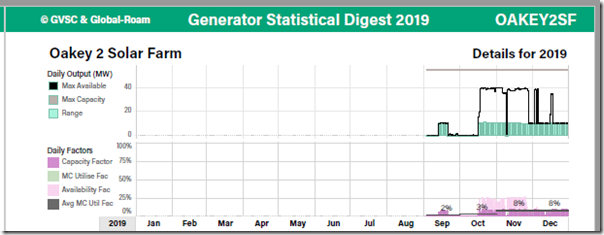
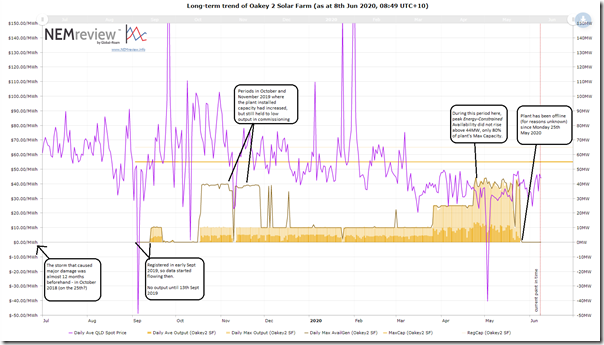
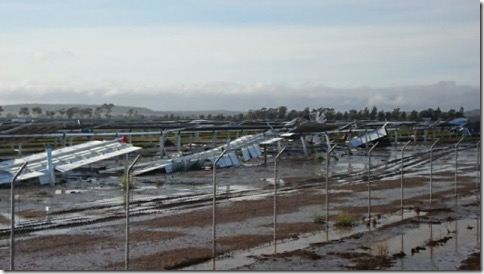
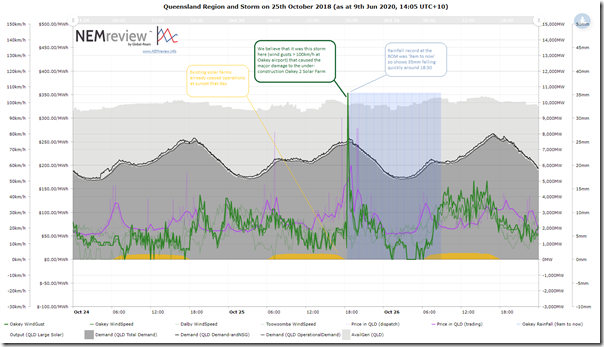
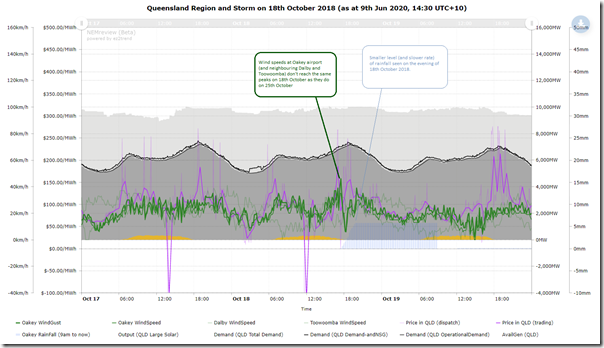
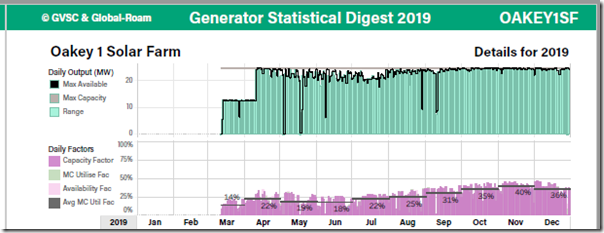
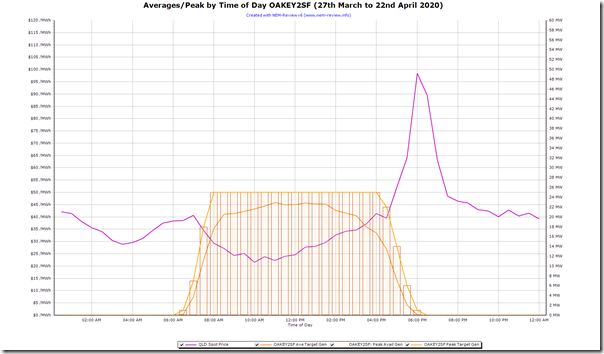
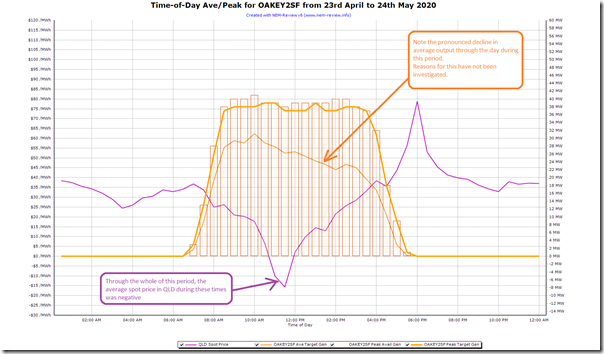
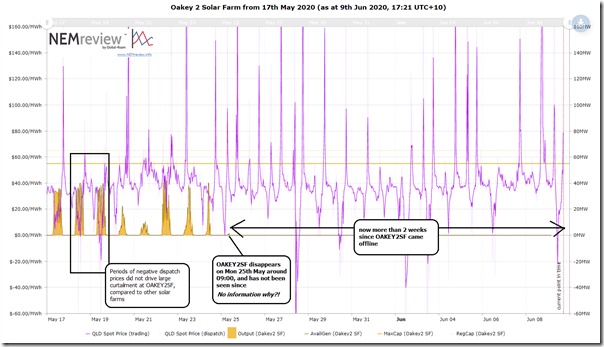
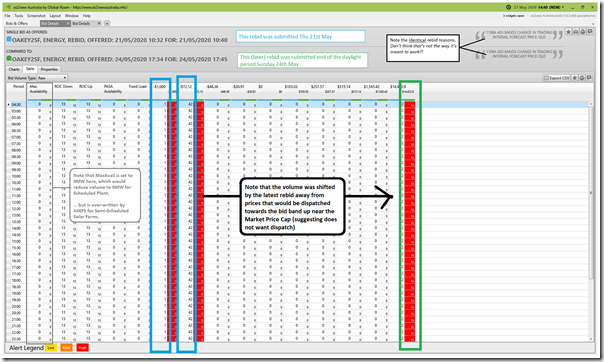
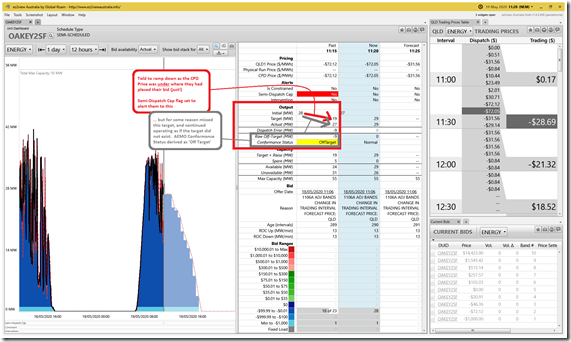
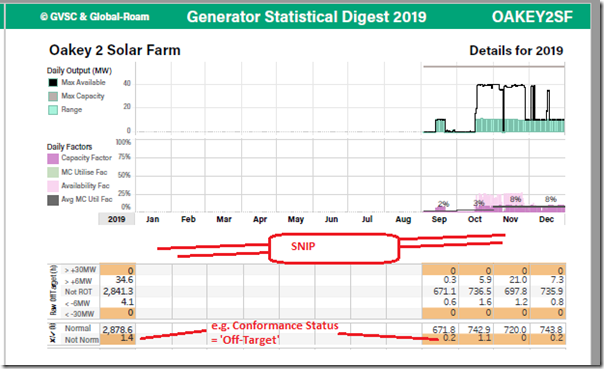
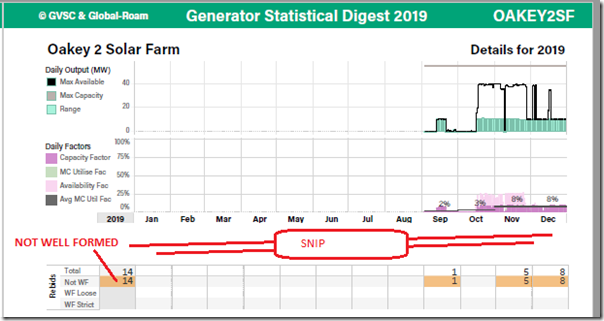
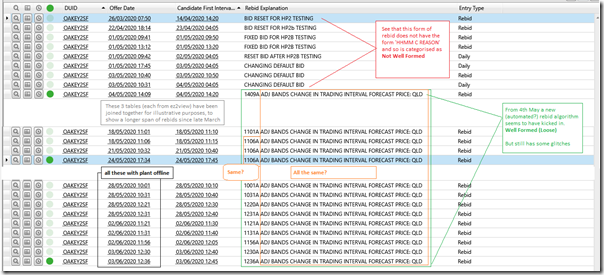
As a useful PS to this article, on Thursday 18th June , Warwick Johnston noted this:
This project only gets worse, it’s now in the courts of Brisbane – no surprises after its history
https://www.courts.qld.gov.au/__external/CourtsLawList/Brisbane.htm
——–
Editor’s Note: CANADIAN SOLAR CONSTRUCTION (AUSTRALIA) PTY LTD -V- RE OAKEY PTY LTD in August 2023